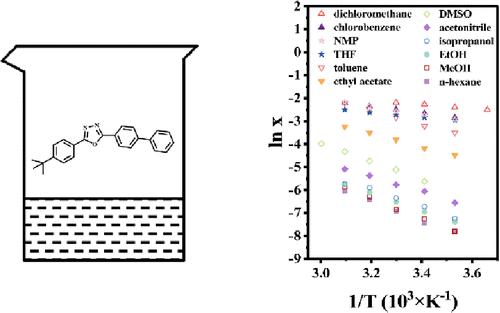当前位置:
X-MOL 学术
›
J. Chem. Eng. Data
›
论文详情
Our official English website, www.x-mol.net, welcomes your feedback! (Note: you will need to create a separate account there.)
Measurement and Model Evaluation of Solubility of 2-(4-tert-Butylphenyl)-5-(4-biphenyl)-1,3,4-oxadiazole in Different Organic Solvents at Various Temperatures
Journal of Chemical & Engineering Data ( IF 2.6 ) Pub Date : 2024-02-28 , DOI: 10.1021/acs.jced.3c00682 Zheng-En Piao 1, 2 , Jingzhou Guo 1, 2 , Dan Wang 1 , Wei Mao 3 , Yuan Pu 2 , Jian-Feng Chen 1, 2
Journal of Chemical & Engineering Data ( IF 2.6 ) Pub Date : 2024-02-28 , DOI: 10.1021/acs.jced.3c00682 Zheng-En Piao 1, 2 , Jingzhou Guo 1, 2 , Dan Wang 1 , Wei Mao 3 , Yuan Pu 2 , Jian-Feng Chen 1, 2
Affiliation

|
2-(4-tert-Butylphenyl)-5-(4-biphenyl)-1,3,4-oxadiazole (PBD) is one of the most widely used electron transport layer materials in optoelectronic devices, and studies on the solubility of PBD in various solvents are critical for development of solution-processable roll-to-roll electronic devices. In this study, the isothermal saturation method is used to determine the solubility data of PBD in 12 commonly used organic solvents. The experimental solubility of PBD increases gradually with enhanced temperature for the examined temperature range of 283.15–323.15 K in n-hexane, methanol, ethanol, isopropanol, tetrahydrofuran (THF), acetonitrile, ethyl acetate, N-methylpyrrolidone (NMP), toluene, and chlorobenzene, while the temperature ranges were 293.15–333.15 K and 273.15–303.15 K for dimethyl sulfoxide and dichloromethane, respectively. The obtained solubility values of PBD are correlated by three models including the modified Apelblat equation, λh equation, and Yaws equation. Comparison of the calculated Akaike information criterion values resulted in selecting the optimal model for each solvent. Of the five solvents calculated, n-hexane, methanol, toluene, THF, and NMP, the λh equation provides an optimal fit. Both the modified Apelblat equation and the Yaws equation work well in chlorobenzene. Among the other six solvents, the fit of the Yaws equation is the best. These results of solubility provide the basic data for the synthesis of PBD nanoparticles via high-gravity-assisted antisolvent precipitation processing.
中文翻译:

不同温度下2-(4-叔丁基苯基)-5-(4-联苯)-1,3,4-恶二唑在不同有机溶剂中溶解度的测量和模型评价
2-(4-叔丁基苯基)-5-(4-联苯)-1,3,4-恶二唑(PBD)是光电器件中应用最广泛的电子传输层材料之一,对其溶解度的研究在各种溶剂中的溶解对于开发可溶液加工的卷对卷电子器件至关重要。本研究采用等温饱和法测定PBD在12种常用有机溶剂中的溶解度数据。在283.15-323.15 K的测试温度范围内,PBD在正己烷、甲醇、乙醇、异丙醇、四氢呋喃(THF)、乙腈、乙酸乙酯、N-甲基吡咯烷酮(NMP)、甲苯、和氯苯,而二甲亚砜和二氯甲烷的温度范围分别为 293.15–333.15 K 和 273.15–303.15 K。获得的 PBD 溶解度值与修正的 Apelblat 方程、λ h方程和 Yaws 方程等三个模型相关。对计算出的 Akaike 信息标准值进行比较,从而为每种溶剂选择最佳模型。在计算的五种溶剂(正己烷、甲醇、甲苯、THF 和 NMP)中,λ h方程提供了最佳拟合。修正的 Apelblat 方程和 Yaws 方程在氯苯中都适用。在其他六种溶剂中,Yaws方程的拟合最好。这些溶解度结果为通过高重力辅助反溶剂沉淀处理合成PBD纳米颗粒提供了基础数据。
更新日期:2024-02-28
中文翻译:

不同温度下2-(4-叔丁基苯基)-5-(4-联苯)-1,3,4-恶二唑在不同有机溶剂中溶解度的测量和模型评价
2-(4-叔丁基苯基)-5-(4-联苯)-1,3,4-恶二唑(PBD)是光电器件中应用最广泛的电子传输层材料之一,对其溶解度的研究在各种溶剂中的溶解对于开发可溶液加工的卷对卷电子器件至关重要。本研究采用等温饱和法测定PBD在12种常用有机溶剂中的溶解度数据。在283.15-323.15 K的测试温度范围内,PBD在正己烷、甲醇、乙醇、异丙醇、四氢呋喃(THF)、乙腈、乙酸乙酯、N-甲基吡咯烷酮(NMP)、甲苯、和氯苯,而二甲亚砜和二氯甲烷的温度范围分别为 293.15–333.15 K 和 273.15–303.15 K。获得的 PBD 溶解度值与修正的 Apelblat 方程、λ h方程和 Yaws 方程等三个模型相关。对计算出的 Akaike 信息标准值进行比较,从而为每种溶剂选择最佳模型。在计算的五种溶剂(正己烷、甲醇、甲苯、THF 和 NMP)中,λ h方程提供了最佳拟合。修正的 Apelblat 方程和 Yaws 方程在氯苯中都适用。在其他六种溶剂中,Yaws方程的拟合最好。这些溶解度结果为通过高重力辅助反溶剂沉淀处理合成PBD纳米颗粒提供了基础数据。



























 京公网安备 11010802027423号
京公网安备 11010802027423号